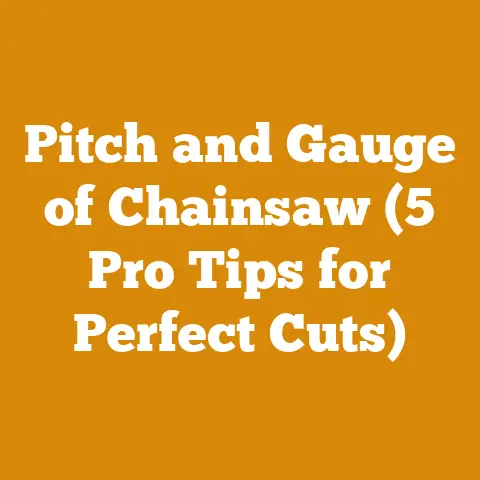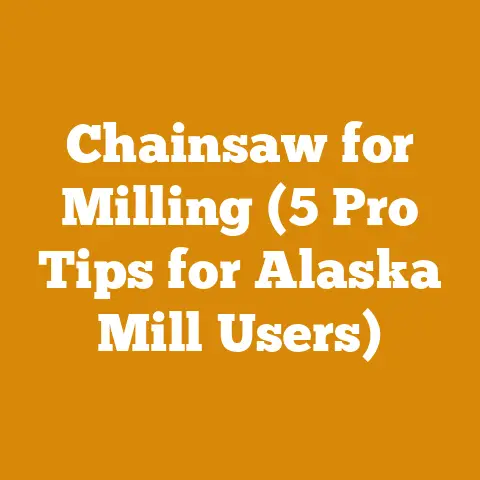How Much Is a Bundle of Wood? (5 Pro Tips for Higher Profits)
Ever wondered how much that neatly stacked bundle of firewood you see at the roadside stand really costs?
More importantly, have you considered how to maximize your profit if you’re the one selling it?
This isn’t just about chopping wood; it’s about understanding the market, optimizing your processes, and running a smart firewood business.
I’ve spent years felling trees, splitting logs, and selling firewood, and I’m here to share my hard-earned wisdom.
We’ll delve into the nuts and bolts of firewood pricing, from raw material costs to the final sale.
I’ll also give you some proven tips to boost your profits without sacrificing quality or customer satisfaction.
Understanding the Firewood Market: A Beginner’s Guide
Before we get into profit-boosting strategies, let’s establish some foundational knowledge about the firewood market.
This will give you a solid base for understanding the rest of the guide.
What is a “Bundle” of Firewood?
The term “bundle” can be surprisingly vague.
Unlike a “cord,” which is a standardized unit of volume (128 cubic feet), a bundle is often a loose collection of pieces held together by twine or plastic wrap.
The size can vary significantly depending on the seller.
- Typical Bundle Sizes: Common bundle sizes range from 0.5 to 1 cubic feet.
You’ll find everything in between, and some sellers even go smaller. - Why the Variation? The lack of regulation allows sellers to adjust bundle size to influence perceived value and stay competitive.
- The “Face Cord” Confusion: A face cord (also called a rick or stove cord) is often mistaken for a standard cord.
It’s typically 4 feet high and 8 feet long, but the depth varies depending on the length of the individual pieces.
This is often used for pricing and selling firewood in larger quantities.
It’s crucial to be clear about what you’re selling to avoid misunderstandings.
Key Firewood Terminology: Green vs. Seasoned
Understanding the difference between green and seasoned firewood is crucial for both pricing and customer satisfaction.
- Green Wood: This is freshly cut wood with a high moisture content (often above 50%).
It’s heavy, difficult to ignite, and produces a lot of smoke when burned.
Green wood is generally cheaper to acquire but requires significant drying time. - Seasoned Wood: This is wood that has been allowed to dry, reducing its moisture content to 20% or less.
Seasoned wood is lighter, easier to light, and burns cleaner.
It commands a higher price due to the time and effort invested in drying. - Moisture Content Matters: The moisture content directly affects the wood’s heating value.
Wet wood wastes energy evaporating water instead of producing heat.
A moisture meter is an essential tool for assessing wood quality and ensuring you’re selling a good product.
Factors Influencing Firewood Prices
Several factors influence the price of a bundle of firewood.
Understanding these factors will help you set competitive and profitable prices.
- Wood Type: Hardwoods like oak, maple, and birch generally command higher prices than softwoods like pine or fir.
This is because hardwoods are denser and burn longer, providing more heat. - Seasoning: As mentioned earlier, seasoned wood is more valuable than green wood.
The drying process requires time, space, and sometimes specialized equipment. - Location: Firewood prices vary significantly depending on your geographic location.
Areas with colder climates and limited wood resources will typically have higher prices. - Demand: Firewood demand peaks during the fall and winter months.
You can often charge higher prices during these peak seasons. - Competition: The number of firewood sellers in your area will influence your pricing strategy.
You’ll need to research your competitors’ prices to stay competitive. - Presentation: A neatly stacked and visually appealing bundle of firewood will command a higher price than a haphazardly assembled one.
- Delivery: Offering delivery services can increase your customer base and allow you to charge a premium.
- Bundle Size: The size of the bundle directly impacts the price.
Be transparent about the volume of wood you’re selling.
5 Pro Tips for Higher Firewood Profits
Now that we’ve covered the basics, let’s dive into the practical strategies for maximizing your firewood profits.
These are the lessons I’ve learned over the years, sometimes the hard way.
Tip #1: Source Your Wood Strategically
The cost of raw materials is a significant factor in your overall profitability.
Sourcing wood strategically can significantly reduce your expenses.
- Free Wood Sources: Look for opportunities to acquire wood for free.
This could include clearing fallen trees after storms, working with local tree removal services, or obtaining wood from construction sites.
Always obtain permission before removing any wood from private property. - Logging Residue: Contact local logging companies and inquire about purchasing logging residue (also known as slash).
This is the leftover wood after logging operations, often available at a lower cost. - Buying in Bulk: Consider purchasing logs in bulk from sawmills or timber companies.
While this requires more upfront investment and processing, it can significantly reduce your per-bundle cost. - Wood Auctions: Keep an eye out for timber auctions in your area.
You might be able to acquire standing timber at a discounted price. - Negotiating Prices: Don’t be afraid to negotiate prices with your suppliers.
Building strong relationships with your suppliers can lead to better deals in the long run. - My Experience: I once secured a deal with a local tree removal company to take all their hardwood logs for free.
All I had to do was haul them away.
This significantly reduced my wood costs for an entire season.
Tip #2: Optimize Your Wood Processing Workflow
Efficient wood processing is crucial for maximizing your output and minimizing labor costs.
This is where the right tools and techniques make all the difference.
- Chainsaw Selection: Choose the right chainsaw for the job.
A larger, more powerful chainsaw is ideal for felling trees and bucking large logs, while a smaller, lighter chainsaw is better for limbing and smaller tasks.
I recommend a chainsaw with a bar length appropriate for the average diameter of the wood you’re processing.
For most firewood operations, a 16-20 inch bar is sufficient. - Log Splitter Investment: A log splitter is a game-changer for firewood production.
A hydraulic log splitter significantly reduces the time and effort required to split wood, increasing your overall efficiency.
Consider investing in a splitter with a tonnage rating appropriate for the type of wood you’re processing.
A 20-25 ton splitter is generally sufficient for most firewood applications. - Ergonomics Matter: Set up your wood processing area to minimize bending and lifting.
Use log decks or platforms to raise the wood to a comfortable working height.
This will reduce strain on your back and improve your overall efficiency. - Debarking Efficiency: Debarking logs before splitting can speed up the drying process and reduce the amount of bark debris in your firewood.
Consider using a debarking spud or a specialized debarking machine for larger operations. - Stacking Techniques: Learn efficient stacking techniques to maximize space and promote air circulation.
A well-stacked woodpile will dry faster and be easier to manage.
I recommend using a crisscross stacking pattern to create air gaps and improve stability. - Case Study: The Hydraulic Splitter Advantage: I used to split all my firewood by hand with a maul.
It was backbreaking work, and I could only process a limited amount of wood each day.
Investing in a hydraulic log splitter increased my production by at least 50%, allowing me to significantly increase my sales volume. - Tool Specifications: My go-to chainsaw for felling is a Stihl MS 261 C-M with an 18-inch bar.
For splitting, I use a 22-ton hydraulic log splitter.
These tools have proven to be reliable and efficient for my firewood operation.
Tip #3: Perfect the Seasoning Process
Proper seasoning is critical for producing high-quality firewood that customers will appreciate.
It’s the difference between a happy customer and a frustrated one.
- Air Drying is Key: Air drying is the most common and cost-effective method for seasoning firewood.
Stack the wood in a sunny, well-ventilated location. - The 6-Month Rule: Aim for a minimum of six months of drying time, but longer is always better.
The ideal moisture content for seasoned firewood is below 20%. - Moisture Meter is Essential: Use a moisture meter to accurately assess the moisture content of your firewood.
This will ensure that you’re selling a properly seasoned product. - Stacking for Airflow: Stack the wood in a way that promotes air circulation.
Leave gaps between rows and layers of wood. - Covering Your Stacks: Covering the top of your woodpile with a tarp or sheet metal can protect it from rain and snow, preventing re-wetting.
- Kiln Drying (Advanced): For faster drying, consider investing in a firewood kiln.
Kiln drying can reduce the drying time to just a few days, but it requires a significant upfront investment. - Data-Driven Drying: I’ve found that oak takes longer to season than maple.
I typically allow oak to dry for at least 9 months, while maple can be ready in 6-7 months.
Regularly monitoring moisture content is key. - Strategic Advantage: Selling consistently well-seasoned wood builds trust with your customers and leads to repeat business.
It’s a key differentiator in the market.
Tip #4: Master the Art of Bundling and Presentation
The way you bundle and present your firewood can significantly impact its perceived value.
A little extra effort can go a long way.
- Consistent Bundle Size: Use a jig or template to ensure consistent bundle size.
This creates a professional look and builds trust with your customers. - Neat Stacking: Stack the wood neatly and tightly in the bundle.
This creates a visually appealing product and maximizes the amount of wood in each bundle. - Secure Binding: Use strong twine or plastic wrap to securely bind the bundle.
This prevents the wood from falling apart during transport. - Attractive Labeling: Create an attractive label that includes your company name, contact information, and a brief description of the wood type and seasoning.
- Professional Presentation: Display your firewood bundles in a clean and organized manner.
Consider using a wooden rack or pallet to elevate the bundles off the ground. - Personalized Story: I once had a customer tell me they chose my firewood over the competition because my bundles were so neatly stacked and professionally labeled.
They said it gave them confidence that I cared about the quality of my product. - Material Specs: I use 120-pound tensile strength twine to bind my bundles.
It’s strong enough to hold the wood securely but easy to cut when the customer is ready to use it.
Tip #5: Marketing and Sales Strategies for Firewood
Effective marketing and sales strategies are essential for attracting customers and maximizing your profits.
- Online Presence: Create a website or social media page to showcase your firewood and reach a wider audience.
- Local Advertising: Advertise your firewood in local newspapers, community newsletters, and online classifieds.
- Roadside Stand: Set up a roadside stand in a high-traffic area.
Make sure your stand is visually appealing and well-stocked. - Partnerships: Partner with local businesses, such as gas stations, convenience stores, and campgrounds, to sell your firewood.
- Delivery Service: Offer a delivery service to customers who are unable to pick up the firewood themselves.
- Customer Service: Provide excellent customer service to build loyalty and generate repeat business.
- Pricing Strategies: Experiment with different pricing strategies to find the sweet spot that maximizes your profits without scaring away customers.
Consider offering discounts for bulk purchases or loyalty programs for repeat customers. - Value-Added Services: Offer value-added services, such as stacking the firewood for the customer or providing kindling and fire starters.
- Original Insights: I’ve found that offering a “firewood starter kit” (including kindling, fire starters, and a bundle of firewood) is a great way to attract new customers and increase sales.
- Strategic Advantage: Building a strong brand reputation for quality and reliability is the best way to ensure long-term success in the firewood business.
Putting It All Together: A Firewood Business Case Study
Let’s consider a hypothetical case study to illustrate how these tips can be applied in practice.
Scenario: You have access to free hardwood logs from a local tree removal company.
You want to start a small firewood business selling bundles at a roadside stand.
Step 1: Sourcing and Processing:
- You collect the logs from the tree removal company, ensuring you have proper permission and safety equipment.
- You use a chainsaw to buck the logs into firewood-sized pieces (approximately 16 inches long).
- You use a hydraulic log splitter to split the wood.
Step 2: Seasoning:
- You stack the split wood in a sunny, well-ventilated area, leaving gaps between rows and layers for airflow.
- You cover the top of the woodpile with a tarp to protect it from rain.
- You monitor the moisture content of the wood using a moisture meter, aiming for a level below 20%.
Step 3: Bundling and Presentation:
- You use a jig to ensure consistent bundle size (approximately 0.75 cubic feet).
- You stack the wood neatly and tightly in the bundles.
- You use strong twine to securely bind the bundles.
- You create attractive labels with your company name and contact information.
Step 4: Marketing and Sales:
- You set up a roadside stand in a high-traffic area.
- You display the firewood bundles in a clean and organized manner.
- You offer a competitive price per bundle, taking into account your costs and the prices of your competitors.
- You provide excellent customer service and build relationships with your customers.
Financial Projections:
- Cost of Goods Sold: Primarily labor (your time) and the cost of twine and labels.
Since the wood is free, your raw material costs are minimal.
Let’s estimate $0.50 per bundle for twine and labels. - Operating Expenses: Roadside stand permit (if required), advertising costs (if any), and transportation costs.
Let’s estimate $100 per month for these expenses. - Selling Price: You research your competitors and decide to sell your bundles for $8 each.
- Sales Volume: You estimate selling 50 bundles per week during peak season (fall and winter).
Profit Calculation:
- Revenue: 50 bundles/week * $8/bundle = $400/week
- Cost of Goods Sold: 50 bundles/week * $0.50/bundle = $25/week
- Gross Profit: $400/week – $25/week = $375/week
- Operating Expenses: $100/month / 4 weeks/month = $25/week
- Net Profit: $375/week – $25/week = $350/week
Analysis:
This case study demonstrates that even with minimal upfront investment, a small firewood business can be profitable.
By sourcing wood for free, optimizing your processing workflow, and mastering the art of bundling and presentation, you can maximize your profits and build a successful business.
Practical Next Steps
Ready to put these tips into action?
Here are some practical next steps you can take:
- Assess Your Resources: Evaluate your access to wood, your available equipment, and your time commitment.
- Research Your Market: Investigate the demand for firewood in your area and the prices charged by your competitors.
- Develop a Business Plan: Outline your goals, strategies, and financial projections.
- Gather Your Equipment: Acquire the necessary tools, including a chainsaw, log splitter, moisture meter, and bundling supplies.
- Start Processing Wood: Begin sourcing, processing, and seasoning your firewood.
- Market Your Firewood: Create a website or social media page, advertise in local publications, and set up a roadside stand.
- Provide Excellent Customer Service: Build relationships with your customers and strive to exceed their expectations.
- Track Your Results: Monitor your sales, expenses, and profits to identify areas for improvement.
Final Thoughts
The firewood business can be a rewarding and profitable venture, especially if you enjoy working outdoors and providing a valuable service to your community.
By following these tips and continuously learning and adapting, you can build a successful and sustainable firewood business that provides you with a steady income and a sense of accomplishment.
Remember, it’s not just about chopping wood; it’s about understanding the market, optimizing your processes, and delivering a high-quality product that customers will appreciate.
Good luck, and happy splitting!






